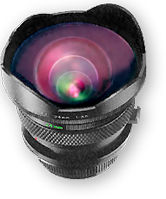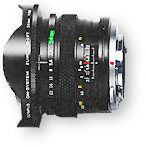The 24mm only has a 10° smaller
angle of view than the 20mm. It provides about twice the image of a 35mm lens and
about three times that of the 50mm lens. Generally, we referred the 24mm lens as
the widest of the wide-angles. Although the focal length is just a small step away
from the super wide-angle lenses, it's a lot easier to use. Second, there's a strong
rendition of perspective that can be controlled quite easily. Previously, it was
like a standard lens for photojournalists who stands to lead in term of usage and
there was a time it was also a focal length that is growing in popularity with non-professional
as well as professional photographers. However, high performance zoom lenses with
superwide coverage slowly phasing out prime lenses of this type. However, Olympus
does not provide any solution for such requirement as thus, these few options still
remains as a favorite among many users for many years.
 |
Within this specific focal length, there are two* 'Star reference' lenses within the Zuiko family. The first is the Zuiko 24mm f2.0 which always had my eyes glued at the shop window during those days. |
It is still one of the fastest lenses available in wideangle lens (perhaps, it shows a slight sign of age when other exotic lenses were introduced such as the New FD Canon 24mm f1.4L. Strangely the Canon does has an Autofocus version of the famed 24mm f1.4L but rarely they mentioned it and in fact NOT many Canon users are awared of its existence).
Other than this, the f2.0 version also incorporates a floating elements design for close range optical correction system to counter aberrations to maintain its excellent optical performance to the extreme close focus distance. It focuses down to 0.25m (0.8ft) and has a 10 elements in 8 group optical composition. Like any other high speed Zuiko optics, the lens minimum aperture is confined to only at f16 and takes in 55mm filters. The lens's weight projects a very well made physical construction and a strong sense of high quality feel.
Zuiko 24mm f/2.0 Lens, Zuiko 24mm f/2.8 Lens
 |
Zuiko 24mm F2.0 |
With a fine reputation for its superb optical characteristics, this lens is an outstanding choice for creative super wide-angle versatility and a practical solution to high quality output is desired under low available light assignment. A definitive lens for photojournalist with its fast lens speed and wider than normal picture angle coverage. Equally handy for newsmen on assignments, travel, architecture, scenic and fashion photography.
Specifications:
Older Version: J Zuiko
AUTO-W 24mm f2.0
Current Version: Zuiko 24mm f2.0
Focal length: 24mm
Lens construction: 8 groups, 10 elements
Angles of view: Diagonal: 84° * More
info on "Picture Angle".
Distance scale: (m) 0.25m to infinity (OO)
Focusing: Helicoid
Minimum and Maximum aperture: f/16-f2.0
Diaphragm: Automatic
Filter size: 55mm
Length: 48mm
Weight: 275g (9.7 oz) (Older version weighs at 280g (9.8 oz)
Recommended
Focusing Screens: 1:1*, 1:2**, 1:3*, 1:4n*, 1:5#, 1:10*, 1:13*,
1:14*
* Compatible. Focusing and
exposure accuracy remains. **
Compatible,
Focusing and exposure accuracy remains intact but microprism, corners of the screen
and split image may
darken. # Can be used, they
provide accurate focusing but exposure error may occur in manual mode for OM1 and OM2 series models.
The best seller among Zuiko's 24mm group of lenses is the f/2.8 version. Naturally, other than many other variable factors, price plays the most important factor because it is almost halve of that of the 24mm f2.0 version (List at USD380-00 (Used (LN): USD130-210) for f/2.8; USD720-00 for the 24mmf2.0 (Used (EX+): USD360-450)*.
The f2.8 lens is made up of 8 elements arranged in 7 groups with a popular retrofocus wideangle design. Despite without incorporating a close range optical correction system, it still manages to close focus down to 0.25m (0.8ft) and weighs almost the same with the 21mm f/3.5 at 180g and its filter size of 49mm enables great compatibility with other filter-attached system accessories.
It is well-suited for interiors
and scenery. An good all round and multipurpose wideangle lens, combining with all
the good elements of compactness, moderately fast speed, light weight, high optical
performance but with a moderately priced to fit most budget.
 |
Zuiko 24mm F2.8 |
*
Street price may be
lowered. But prices for used units hold the key, but you need to have a lot of patience
and always select a reputable store.
Specifications:
Older Version: H Zuiko
AUTO-W 24mm f2.8
Current Version: Zuiko 24mm f2.8
Current Version: Zuiko 24mm f2.8
Focal length: 24mm
Lens construction: 7 groups, 8 elements
Angles of view: Diagonal: 84°
Distance scale: (m) 0.25m to infinity (OO)
Focusing: Helicoid
Minimum and Maximum aperture: f/16-f2.8
Diaphragm: Automatic
Filter size: 49mm
Length: 31mm
Weight: 185g (6.5 oz) (Older version weighs at 180g (6.3oz)
Recommended
Focusing Screens: 1:1*, 1:2**, 1:3*, 1:4*,
1:5# 1:10*, 1:13*, 1:14*
* Compatible. Focusing and
exposure accuracy remains. **
Compatible,
Focusing and exposure accuracy remains intact but microprism, corners of the screen
and split image may
darken. # Can be used, they
provide accurate focusing but exposure error may occur in manual mode for OM1 and OM2 series models.
|
Reserved Sample image 1 |
Reserved Sample image 2 |
Reserved Sample image 3 |
Reserved Sample image 4 |
Reserved Sample image 5 |
N O T E: As no photographer in the world would possess ALL the lenses within a single trade name. You are always encouraged to replace these reserved slot for sample images above shooting with a lens type detailed above - just mail in your creative visual, a little caption relative to the background information will help a lot to let other understand how you prepared the shot. Please mention IF you require a complimentary link and where should it be pointed at. Naturally, I DO NOT like to disappoint anyone, but in order to maintain my self-set standard in the PIM website - I would prefer to have high quality input rather than in quantity, if your image is NOT selected for broadcasting in this site, give it a try the next time but I do promise every image will be view and consider carefully. I do appreciate your consideration in this matter.
Unlike large format cameras where they offers more freedom in the camera movement in permitting direct or indirect parallel shift and a system of center swings and tilt for both front and rear standard for finer control of sharpness in depth; 35mm's bellow unit is usually meant for macro rather than used for similar function as with the large format cameras.
To 'simulate' such functionality, 35mm camera manufacturers use a lens based system for shift and tilt control to adjust the axis. Most relate and restrict it for architectural photography which makes a lot of sense, as most agencies would preferred larger format transparencies than 35mm format if works is confined to indoor shootings. Canon claimed their FD TS (Tilt & Shift) 35mm f/2.8 introduced back in 1973 was the world's first 35mm lens that offer such function, but I doubt such claim because Nikon has a similar Perspective Control lens, PC-Nikkor 35mm f2.8 which was introduced much earlier back in 1962 (Naturally, if you use a "TS" lens designation, that was the first then).
Olympus offers two options in SHIFT lens, another is the Zuiko 35mm f2.8 SHIFT which was introduced in the early part of '70 after the debut of OM1. The Zuiko 24mm f3.5 SHIFT was not made available even when the OM2 was introduced back in 1975. It was an instant classic as no camera manufacturers had ever attempt to offer with an ultra wideangle in a 24mm range. In fact, Olympus's achievement was only matched some 20 years later by the Canon with their electronic Autofocus EF-mount TS 24mm f/3.5L.
 |
The SHIFT ("TS": tilt & shift or "PC": Perspective Control) lens has an unique optical design to permit depth of field and perspective control. It is designed to tilt or shift its axis in relation to the film plane. |
The angle of the lens' axis to the film plane can be changed to either control depth of field thereby increasing sharpness in the image or correct unnatural perspective. Both tilt and shift movements can be adjusted to work either vertically or horizontally by rotating the lens. Although generally used for two purposes, tilt (depth of field) or shift (perspective), this lens' internal mechanism is designed to perform the two functions simultaneously. With angle of view the same as that of the conventional 24mm ultra-wideangle lens, the Zuiko 24mm lens has a fast lens speed of f/3.5 and focuses down to 0.35m at its closest distance. Further, it uses an ED (Extra low dispersion) glass for the front lens element which has an special optical characteristic to counter chromatic aberration and assure excellent peripheral resolution.
While most 35mm lenses have an image circle just large enough to cover the 35mm film format - about 43mm. A 24mm ultrawides has a normal picture angle of 84°, the Zuiko 24mm f/3.5 SHIFT has an image circle measuring more (Maximum 100° ) which permits the lens to cover the entire image area even at maximum tilt or shift positions. In most cases, the lens could be portraying as a problem solver but it is also capable of taking the images that may challenge your creativity with its unique optical characteristic. The lens requires stopped down exposure measurement (More info on the Zuiko 35mm SHIFT lens section).
 |
Zuiko Shift 24mm F3.5 |
It adopts extra low distortion glass for the front lens element, and minimizes chromatic aberration to assure excellent peripheral resolution. Due to its protruding and the extra large front element, the lens was designed with a built-in filters where a Neutral Density, Y48, O56, R60 are provided.
Specifications
Focal length: 24mm
Aperture ratio: 1:3.5
Construction: 10 groups, 12 elements;
Angles of view: Standard 84°; maximum shift 100°
Distance scale: (m) 0.35m to infinity (OO)
Minimum aperture: f/22
Filter size: Built-in (Neutral, Y48, O56, R60)
 |
Hood: BW-58 |
* Compatible. Focusing and exposure accuracy remains. ** Compatible, Focusing and exposure accuracy remains intact but microprism, corners of the screen and split image may darken. Note: No references given with compatibility with older OM1 or OM2 series cameras but you can refer more at the G-Zuiko AUTO-W 35mm f2.8 SHIFT for more info.
| Back | Index Page of OM Zuiko Lenses